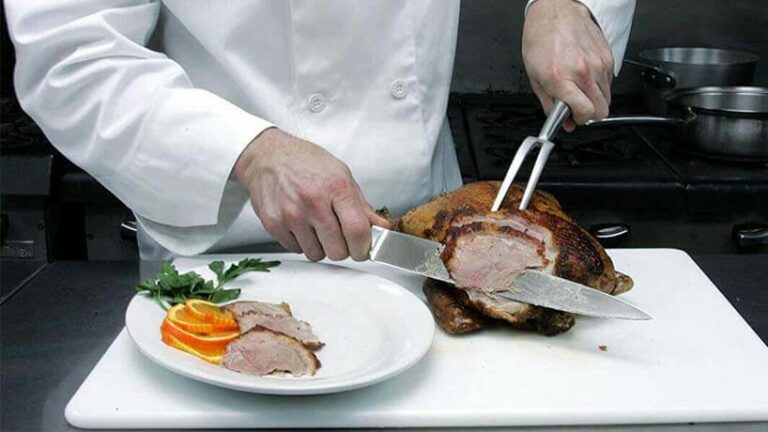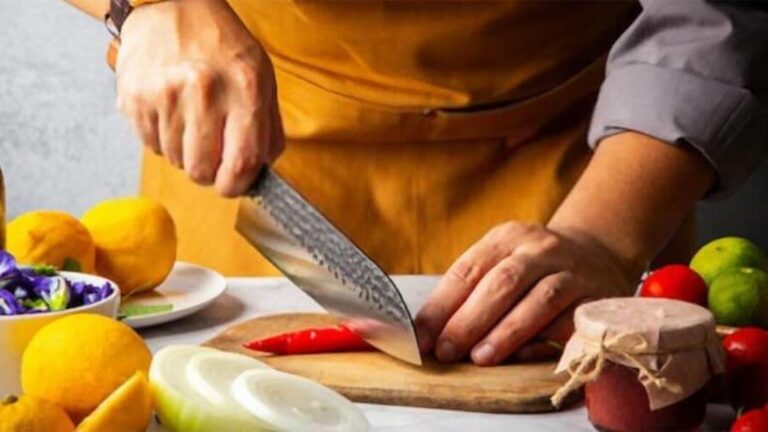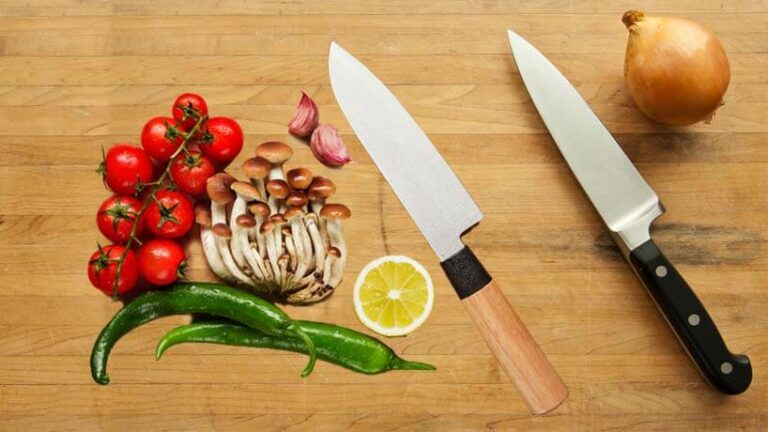The santoku knife vs chef knife debacle has plagues knife enthusiasts for a long time. This is especially true if you’re just getting into the high-performance knife market. There are a bunch of essential differences that you need to know before making your choice. While these knives are similar, mistaking one for the other can put a big block in your path to improvement.
In this guide, you’ll learn about these key differences in detail. We’ve highlighted what you need to pay attention to – along with some tips for the best uses and techniques for each of the knife types. By the end, you’ll be ready to make an informed decision. You’ll get a knife that suits your style, niche, and planned uses – helping you get better results in the kitchen!
Differences Between a Santoku vs Chef Knife
As we mentioned above, we’re going to go into detail on each of the important differences between this hugely popular santoku vs chef knife. We’re going to cover differences in shape, size, looks, price, uses, and more. We’ll also show you the best way to use each knife to make sure you’re getting the best possible performance from the knife. Let’s get started!
What Is a Santoku Knife Used for?

Santoku knives are probably the lesser-known of the two. You probably came across these Japanese functional-masterpieces a little while after you heard about the charms of the modern chef’s knife. While they’re widely used in Japanese homes and professionals kitchens alike; these knives are gaining incredible traction around the world.
Their popularity is spreading just as fast as peoples’ fascination with other cultures and experiences. With that said, the santoku shares many similarities with the chef’s knife. They’re both used to general utility and meal preparation in the kitchen. Both knives are incredibly versatile for handling vegetables, herbs, fruits, and light meats. Santoku knives tend to stand out when it comes to chopping ability.
Their straighter cutting edge and consistently tall blade profile give them exceptional chopping power. Whether you’re chopping herbs or thicker pieces of meat, these knives are incredibly versatile. They handle slicing exceptionally well too. With their extremely sharp edges and a slight forward motion, they cut through light meat (especially fish) exceptionally well.
Santoku knives excel when it comes to handling more delicate and precise cutting work. The tip doesn’t get in the way and the straight edge lends to incredible accuracy. The word santoku roughly translates to “three virtues”, and many argue that this refers to its uncanny ability at slicing, chopping, and mincing.
What Is a Chef Knife Used for?
Chef’s knives are widely known as the “workhorse” of the kitchen. They’re adored by professional chefs and have crept their way into almost every cooking enthusiasts’ kitchen. These knives are designed for the famous “pinch grip”. You’ve most likely seems them being used in a laser fast rocking motion.
Other than giving you a little anxiety for chef’s fingers, they’re incredibly well-suited to dicing and mincing. You’ll find the curved blade is perfectly suited to this type of chopping. The base of the cutting edge (nearest to the handle) is used for heavier slicing with thicker meats. The pointy tip is excellent for piercing and working around bones.
You’ll have no trouble working on a variety of meats. You’ll often see the side of the blade being used to crush and press garlic, among other herbs. Overall, the chef’s knife does a lot of the same things that a santoku does – just with a little more emphasis on handling some heavier duty cutting tasks.
Shape and Design
The santoku knife has a blade that sits lower down in relation to the handle. This gives more space for your fingers to sit in a grip that favors up-and-down chopping. If you tried this same technique with a chef knife, you’d find your knuckles either pummeling the chopped food – or the cutting board. Neither a very pleasant.
A notable feature of many santoku blades is the dimples or “dents” along the sides of the blade. They’re usually found on the half of the blade closest to the cutting edge. While some chef’s knives have these dimples, they’re far more common on santoku knives.
These dimples are used to create air-pockets that stop the thin slices of meat from sticking to the sides of the blade. Santoku knives also have a thinner/slimmer/smaller bolster. This the smooth piece of metal that gradually widens from the blade and transitions into the handle.
Chef’s knives need a larger bolster to make the pinch-grip easier and suitable for a wider range of hand sizes. Finally, the santoku has a more pronounced curve in its spine (near the tip). We’ll talk more about the tip in a moment, but you’ll notice the santoku has a taller blade for its last 3-4” near the tip.
Weight and Size
Chef knives are generally heavier and longer than your average santoku knife. Several hybrid brands infuse the curved blade from the chef knife with the traditional features of the santoku. The santoku’s blade is wider and has a more consistent height right up to its swift curve near the tip. Aside from these two major size and weight differences, the knives don’t have much that set them apart in this category.
Cutting Edge and Tip-Style
Santoku knives are typically sharper than an equivalent chef knife. This is partly due to the single-beveled cutting edge and the type of steel used. If you get a premium knife from either side though, there’s not going to be much of a perceivable difference in how they perform in a cutting test.
Aside from the odd-one-out, the cutting edge on a santoku knife will be straight (or very close to straight). They weren’t designed to be used with a rocking motion, and the straight edge handles the up-and-down chopping better. As we’ve already hinted at, santoku knives often have a single-beveled edge.
This lets them get an impeccably sharp edge without needing as much sharpening time and effort. The bevel on chef knives is usually around 15°, whereas the bevel on a santoku is around 10°. This is one of the reasons that santoku knives are particularly good at working with fish. The ultra-sharp and thin blade protect the integrity of the meat, letting you get exceptionally thin slices quite easily.
Finally, the santoku has a squared-off tip that sits closer to the line of the cutting edge. You’ll find the chef knife’s tip sits higher up and closer to the centerline of the knife. It’s also pointed and incredibly sharp (so mind your fingers)! This pointed and raised tip is excellent for pivoting on the cutting board for the rocking cutting motion.
How to Use a Chef Knife

They’re designed to be used with a rocking motion. As you’re holding the knife, you’ll push into the cut by lowering and pushing the handle. This glides forwards into the cut. When you come out of the cut, you simultaneously raise and pull on the handle. The food falls away as you do this.
You’ll find the technique feels a little strange at first – especially if you’ve never tried it before (if you’re switching from a santoku for example). What unique about this rocking back-and-forth cutting motion is that the blade never leaves the cutting board.
It makes contact throughout the cut and through the pull-back motion. Chef knives are build and balanced to be used with a pinch grip. This is usually around the bolster area – though your fingers will often rest on the finger guard.
How to Use a Santoku Knife
Santoku knives are made for rapid up-and-down chopping. While they can be used with gliding cutting motion, you’ll find the straight edge of the blade doesn’t let you rock like a chef knife. Cutting with this gliding motion is probably what you’re used to if you’ve never used a santoku before.
You should work on the right technique for chopping if you want to get the most out of this knife. You’ll hold your santoku knife toward the blade-side of the handle, completely covering the thinner bolster. Your thumb will rest on the side of the blade, with your index and middle fingers directly opposite it.
This puts you a little in front of the knife’s center of balance – and that’s exactly what we’re going for. Your other hand can be used to guide the knife to the right chopping point (with the nail or side of your finger. This technique takes a while to get right and is a little risky until you do.
You’ll find that you can build up impressive chopping speed and accuracy once you get used to holding your santoku with the right grip. These knives often have a higher-skill requirement. You’ll need to learn and master a couple of different grip and techniques before you can use this knife to its full potential.
Caring for Your Premium Knives
Now that we’ve covered all the main differences between these impressive knives, let’s take a moment to talk about caring for them. While it’s a little beyond the scope of this guide, we still want you to get the best possible performance from your knife. That all begins with the right care and maintenance routine.
Most premium knives will come with some kind of hard case where you can store the knife. If yours didn’t, make sure you’re keeping it is a dry spot that’s out of direct sunlight. NEVER wash these knives in a dishwasher. Despite being made from premium steel, they can be damaged by other metals and hard objects easily.
Wash them by hand and don’t drop them in the sink. Avoid heavy cleaning chemicals and detergents. We find that a simple mix of warm water and soap does the trick. Once you’ve washed them, you should wipe them down and let them air-dry. You never want to leave these knives on a cold and hard surface while wet (or into their case). This is the fastest way to rust and corrode your precious knife into oblivion.
Final Thoughts
We’ve covered a lot of information in this guide. If this is your first time owning a premium knife, make sure you have good care and maintenance plan in place from the get-go. There’s not much worse than spending a pretty penny on a premium knife, only to have it fade into uselessness because it wasn’t well-cared for.
These fabulous knives are an investment – they’ll reward you well when you put in the effort. Now that you’re ready to choose which knife is right for you! Take what you’ve learned in this santoku knife vs chef knife comparison and go check out a couple of options – good luck!







